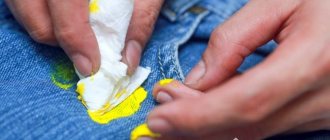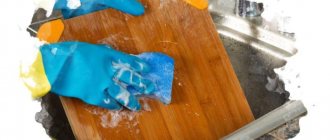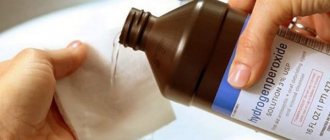Let's look at how to remove grease stains at home. Such contamination on clothes can bloom even in a very neat person. For example, someone walked by, snacking on fried potatoes from a fast food restaurant, and dropped one right on the jacket of a passerby who happened to be nearby.
An incident, but not necessarily fatal for a dirty item: today there are a lot of products for washing and removing greasy stains of any origin. Yes, and there are many grandmother’s techniques. So you can always compete for your favorite outfit and ultimately win.
- Removing fat from clothes
- Tips for getting rid of fresh stains
- Removing old stains
- Nuances when processing wool, silk and cotton
- Removing fish oil
Removing fat from clothes
When choosing a method, you need to take into account the color reliability of the fabric, the chemical characteristics of the material and the aggressiveness of the stain remover.
Dish detergent
Only substances for washing dishes are suitable. Aggressive products with acid or concentrated alkali cannot be used to clean fat from the walls of pots - such a liquid quickly destroys the fibers of the fabric and can even burn a hole in it.
Dishwashing liquid
To increase the effectiveness of the gel, a drop of the substance is distributed directly over the stain. After a quarter of an hour, the item is dipped into a container with a small amount of water and a liquid degreasing agent. You shouldn’t pour it a lot: it won’t affect the result of the process, but it will be difficult to rinse the product.
On what things can you use:
- Jeans and any trousers or trousers made of thick or thin fabric.
- Curtains, drapes and tulle. The smaller the volume of gel added during washing, the less often you need to rinse.
- Carpets and rugs. Remains of dried foam are removed with a vacuum cleaner.
- Knitted items: T-shirts, fabrics, blouses, T-shirts.
- Fur coats, sheepskin coats. The main thing is not to overdo it with the volume of added substance and thoroughly wash off its remains; when processing fur, use a spray bottle rather than wet the completely contaminated area.
What you shouldn't do
To remove an unpleasant fishy smell from clothes the first time, you need to wash or soak the item as soon as possible after contamination, before the aroma has penetrated into the deep layers of the fabric. When washing, it is not recommended to add other items that do not have a fishy smell to the machine to prevent the smell from spreading to them.
Outerwear cannot always be washed; stains and odors are more difficult to deal with. The skin is wiped with a solution of citric acid, ascorbic acid, and hydrogen peroxide. Clothes made from thick fabrics should be dry cleaned to avoid getting damaged. Small stains can be removed by vinegar or lemon, if possible, rinse the treated area in running water. But the best way to get rid of fish smell is not washing, but the precautions taken when purchasing, cutting and preparing the fish.
The article has been verified by the editors
Tips for getting rid of fresh stains
The faster you act on fat, the easier it is to remove it from the tissue.
How an iron can help
Its benefits in the fight against oily stains are relative. Heat not only helps the grease to be absorbed onto the underlying cloth or layer of starch, but also makes it easier for dirt to penetrate deep into the fibers of the item itself. And if you choose the wrong temperature, the fat will only stick to the outfit. Therefore, when getting rid of contaminants, it is better to use less risky methods.
Ammonia
A solution containing ammonia does a good job of removing greasy stains of various ages. Prepare a mixture of 2 parts boiled water and one part ammonia. This substance does not smell very pleasant, so it is only suitable for home use.
The stain is treated in several stages, each time washing the area of the item and blotting it from excess moisture before applying the next portion of the mixture. Wool, cotton, silk or fabrics with unstable colors may not withstand the effects of such a degreaser.
Shampoo for oily hair
The product will cope well with the most recent stains, but it is ineffective against old marks. Still, the task of shampoo is to partially remove fat and dust from the hair, and not to degrease the scalp and hair, as they say, until it squeaks.
Do you wash by hand?
Oh yes! No
Powder absorbents
Outside the home, when there are no special anti-stain products at hand, you can always use:
- Lime powder (you will have to find a wall painted with lime and use your fingernail to get a couple of pinches of white dust).
- Talcum powder (mothers walking with their children will help out).
- Loose powder.
- Starch (if you are visiting a friend and the stain is not on a fur item - the latter are difficult to clean from the remnants of potato flour).
The processing principle is the same as when using salt and soda.
Laundry soap
It has an excellent effect on fresh stains, but its chemical properties are not enough to combat old traces of fat. Mixing with turpentine and ammonia is not very rational, because the resulting mixture is quite caustic and can damage delicate fabrics and leave stains on dense ones.
Chalk
It perfectly absorbs fat from fabrics, so you can carry a couple of pinches with you in a plastic bottle so that you are always ready to defend the attractive appearance of your item. You should not use chalk on fur, especially dark fur - during the wet cleaning process it can stick together in small lumps, which will greatly spoil the overall appearance of the product.
Laundry soap
General breeding rules
It is important to remember that improvised means and household chemicals will not always give a positive result in the fight against fish odor. You can remove it from cotton fabrics yourself. If outerwear, silk, satin, lace or thin synthetic items have been soiled, you will have to take them to the dry cleaner. At home, when using traditional methods, the above-described items of clothing can easily be damaged, so it is better not to take risks and entrust the work to professionals. In other cases, you should try to get rid of the smell on your own.
It is important to remember that products such as citric acid, baking soda and vinegar can cause brightly colored items to fade.
Removing old stains
An old greasy mark in a visible place of a favorite thing is not yet a reason to write it off as scrap. If special means do not help, you can use an “explosive” mixture according to grandmother’s recommendations.
Turpentine and ammonia
The hated stain is treated with a composition of equal parts of the components. Before the process, be sure to wear thick rubber gloves and first test the reaction of the fabric to the resulting liquid.
Salty water
Washing in “sea” water can help remove greasy stains if you soak the soiled item in a salt concentrate of 3 liters and 100 g of salt.
The product is not suitable for cleaning sheepskin coats because it leaves salt stains on the leather and, upon contact with it, changes the appearance of the latter. Do you wash your shoes in the machine?
Oh yes! No
Petrol
Use only purified ones, used, for example, for refilling lighters. Treat the stain from the edge of the halo to the center. Do not use on materials containing synthetic fibers. When working, follow fire safety precautions.
Glycerol
The chemical properties of glycerin, enhanced by the qualities of ammonia, are used to clean expensive fabrics such as velor, velvet, and silk.
The mentioned substances are mixed with ordinary water in equal parts, and then the contaminated area is moistened and left for a couple of hours. Then they wash it, observing the temperature regime recommended for the material. Glycerol
Steam
Exposure to evaporating water is used to soften fat in contaminated tissue. Immediately after the steam bath, the item is treated with gel dishwashing detergent, and after a quarter of an hour, washed in the usual way.
Starch, gasoline and stale bread
Not the most effective option for treating fabrics, since gasoline has the main degreasing effect. And it is better to clean it with materials that are more absorbent than bread or starch.
How to remove fish stains from a down jacket or jacket
Jackets and down jackets may also develop fish stains that need to be removed. You can use the following products: paper towel, turpentine, stain remover, iron and washing powder.
The steps are simple:
- To remove a fresh stain, just take a sheet of paper or a napkin, heat the iron, place the sheet on the stains, and iron it. All the fat will remain on the paper.
- You can use modern stain removers. Such products must be used strictly according to the instructions indicated on the packaging.
- If a feather is used as a filler for outerwear, then you can remove stains with turpentine, but you need to act as carefully as possible so that the solution does not penetrate into the filler. You need to dip a cotton pad in turpentine and treat the problem area. Repeat the procedure as necessary.
Starch
Starch can be used to remove grease from fabrics that cannot be washed by hand or in a washing machine. The course of action is as follows:
- The freshly contaminated area is covered with dry starch.
- The powder is lightly rubbed into the fabric and kept in it for at least 20 minutes.
- The procedure is repeated several times until the contamination disappears from the material without a trace.
For your information! For old stains you will need to use hot starch. The powder is also applied to the old stain, covered tightly with a white cloth on top and slightly heated with an iron. Since the fat will be absorbed into the powder slowly, the procedure will have to be repeated several times.
Boiling
Another method of getting rid of fishy smell is boiling. This method is considered “heavy artillery”, since it does not have a beneficial effect on the tissue.
Unpleasant odors are removed from clothes by boiling in a solution made from laundry soap and water. Boiling is performed as follows:
- the prepared solution is poured into a basin or pan;
- then clothes that emit an unpleasant odor are placed in the selected container with the solution;
- after this, the solution is brought to a boil;
Things are boiled over low heat for 40 minutes. Periodically you need to add water to the container.
If your clothes smell like fish, you can remove this unpleasant odor in various ways. Whatever method is chosen, the following recommendations must be adhered to:
- if your clothes often smell like fish because of your profession, then you need to remove the smell and stains from several things at once. This saves both money and time with the cleaning product;
- if it is not possible to immediately wash fish-stained clothes, then they are wrapped in newspapers. They absorb unpleasant odors well. Moreover, after being in the newspaper, things are usually washed much easier. This is due to the fact that newspapers will absorb most of the fishy smell;
- The aroma of fish is easily removed by vinegar. It is enough to add a few tablespoons of vinegar to the soap solution. Therefore, it can be added in small quantities both to soaking solutions and used when washing. Here you need to rinse clothes especially carefully. Rinsing is done in a large volume of water. Otherwise, stains or chemical stains may appear on things;
After the clothes have been washed, it is recommended to dry them in a ventilated area. It is best to hang it outdoors. The stronger the smell, the longer the clothes should be left in the air (for example, a day). Cold air or frost has a positive effect.
Remember that the key to effectively eliminating fish aroma is quickly treating contaminated items.
Soak
If you are afraid that the machine will not be able to clean the product and eliminate odors, and you don’t want to waste time, then try soaking the item before removing the smell of fish oil from clothes. Here you can use the following options:
- In a solution of hot water and a large amount of laundry soap shavings.
- A similar option is to soak the item in a solution of warm water and a small amount of vinegar. This way, it will be much easier for the machine to cope with the task, and you are guaranteed to get the best result after the first wash.
- White items are soaked in bleach. The most important thing is that the product does not contain chlorine, which can harm the material. Soak the item in it and leave it for an hour, then put it in the washing machine.
Folk remedies
Often, to get rid of the unpleasant smell of fish, it is enough to use one of the home recipes:
- To permanently remove fish smell from clothes, you can use baking soda. It even removes old fishy smells. Instead of detergent, load a glass of soda into the powder receptacle and wash as usual.
- Add 2 tablespoons of vinegar to a basin with 3-4 liters of warm water. Immerse things and leave for 2 hours. Then rinse thoroughly and wash.
- Dilute 2 tablespoons of vinegar in 2 liters of water. In the resulting solution, wash things with laundry soap. After several rinses, hang it out to dry in the fresh air.
- Things are placed in cold water with salt diluted in it for several hours, then sent to the wash.
In winter, when dried in the cold, unpleasant odors quickly disappear. In summer, you should not dry things in the sun. Ultraviolet light fixes odors in fabrics.
Preparatory stage
Before cleaning, you need to remember a few simple rules and prepare the necessary materials for this:
First of all, carefully study the label from the manufacturer.
There you can find recommendations for the choice of detergents, washing mode and water temperature. Do not neglect this rule, as this significantly increases the chances of not ruining your clothes when washing.- Prepare the necessary materials: cotton cloth or paper, a soft brush, a cotton pad or a piece of clean cloth, clean water and materials for the solution.
- Using a soft brush, you need to clean your clothes from foreign objects: dust, wool, dirt, etc.
- When diluting the solution, use the weakest concentration; if there is no effect, then gradually increase it.
- Be sure to turn the item inside out. Place a cotton towel or paper under the stain, first folding it in several layers, and only then begin cleaning.
The main differences between fresh and old pollution
The main difference between the two types is how much fat is absorbed into the fabric . If the stain was planted relatively recently, it will be much easier to remove. Many remedies that can be found in any housewife’s home will help you get rid of it.
With outdated ones the situation is much more complicated. Since the grease is already well absorbed into the fibers of the fabric, simple methods are highly likely to fail to remove it. To do this, you will need to resort to stronger and more expensive cleaning products.
Dry cleaning
If after all the above cleaning methods the smell of fish remains on the cleaned clothes, then the last hope remains - chemical washing.
Dry cleaning is used when the fabric of the clothing is very delicate. In this case, using vinegar, soda or boiling will cause it to become unusable. At the same time, dry cleaning is considered a radical method of combating unpleasant odors.
The main disadvantage of this method is its high cost. However, dry cleaning specialists have at their disposal an extensive arsenal of a wide variety of cleaning products to combat all types of dirt and unpleasant odors. Therefore, dry cleaning will give a 100% clean result.
Knowing how to remove the persistent smell of fish from clothes, you can save your favorite item and return it to a pleasant aroma. After all, you shouldn’t give up your favorite treat or take an effective medicine (fish oil) because of the danger of staining your clothes. With the right approach, the problem of fishy odor can be solved quite simply.











